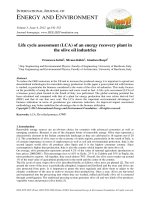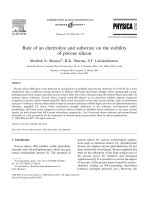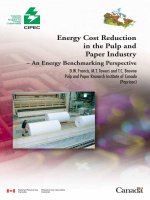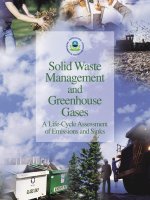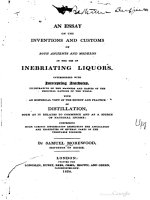- Trang chủ >>
- Khoa Học Tự Nhiên >>
- Vật lý
Life cycle assessment (LCA) of an energy recovery plant in the olive oil industries
Bạn đang xem bản rút gọn của tài liệu. Xem và tải ngay bản đầy đủ của tài liệu tại đây (926.69 KB, 12 trang )
I
NTERNATIONAL
J
OURNAL OF
E
NERGY AND
E
NVIRONMENT
Volume 3, Issue 4, 2012 pp.541-552
Journal homepage: www.IJEE.IEEFoundation.org
ISSN 2076-2895 (Print), ISSN 2076-2909 (Online) ©2012 International Energy & Environment Foundation. All rights reserved.
Life cycle assessment (LCA) of an energy recovery plant in
the olive oil industries
Francesca Intini
1
, Silvana Kühtz
1
, Gianluca Rospi
2
1
Dep. Engineering and Environmental Physics, Faculty of Engineering, University of Basilicata, Italy.
2
Dep. Engineering and Environmental Physics, Faculty of Architecture, University of Basilicata, Italy.
Abstract
To reduce the GHG emissions in the UE and to increase the produced energy it is important to spread out
decentralized technologies for renewable energy production. In this paper a power plant fed with biomass
is studied, in particular the biomass considered is the waste of the olive oil industries. This study focuses
on the possibility of using the de-oiled pomace and waste wood as fuel. A life cycle assessment (LCA) of
a biomass power plant located in the South of Italy was performed. The global warming potential has
been calculated and compared with that of a plant for energy production that uses refuse derived fuel
(RDF) and that of one that uses coal. The LCA shows the important environmental advantages of
biomass utilization in terms of greenhouse gas emissions reduction. An improved impact assessment
methodology may better underline the advantages due to the biomass utilization.
Copyright © 2012 International Energy and Environment Foundation - All rights reserved.
Keywords: LCA;
De-oiled pomace
;
GWP
.
1. Introduction
Renewable energy sources are an obvious choice for countries with advanced economies as well as
emerging countries. Biomass is one of the cheapest forms of renewable energy. Olive trees represent a
characteristic element in the Italian countryside landscape as they are cultivated in 18 regions out of 20
[1]. The contribution of olive trees to the economy of entire regions, particularly in the south of Italy, is
of extreme importance in terms of employment as well as soil and environmental protection. Italy is the
second largest world olive oil producer after Spain and it is the highest consumer country. Since
consumption is higher than production, Italy is also the country which imports the most olive oil.
On average, olive production represents around 4.2% of the value of national agriculture (production at
base prices 2000/2001). This percentage rises to 10% in Sicily, 25 % in Calabria and 35% in Puglia, the
most productive regions. All together, they reach almost 70%. Overall, the olive sector makes up around
1% of the total value of agricultural production in the north and the centre of the country.
The life cycle of extra virgin olive oil is described briefly as follows: olive trees are planted [2]. The soil
around the roots of the trees is periodically ploughed, irrigated and fertilized and the trees and olives are
also protected from pests. It is important to prune the trees regularly and allow them to adjust to the
climatic conditions of the area in order to increase their productivity. Once a year, olives are harvested
and transported into the processing unit where they are washed, milled and finally olive oil is extracted
through centrifugation. The traditional pressing system generates olive oil and two kinds of by-products:
vegetable water and pomace (olive husk) [3].
International Journal of Energy and Environment (IJEE), Volume 3, Issue 4, 2012, pp.541-552
ISSN 2076-2895 (Print), ISSN 2076-2909 (Online) ©2012 International Energy & Environment Foundation. All rights reserved.
542
Pomace is commonly used for extracting crude olive-pomace oil for producing fodder, for thermal
energy recovery or as a fertilizer. With the extracting phase the de-oiled pomace is produced and burned
in the furnaces.
This study aims to analyse the environmental advantage (in terms of GWP, Global Warming Potential)
deriving from the use of de-oiled pomace (60%) and waste wood (40%) in an energy plant based on site-
specific data and information, and to compare its environmental impact with that generated by the
recovery of RDF and of coal combustion.
In the literature there are several studies on the de-oiled pomace.
In particular, [4] and [5] analyzed the use of the olive oil industry waste as fuel to obtain thermal or
electric energy through combustion.
Russo et al. [6], showed that the recovery of olive pit and solid wastes offers environmental advantages
with respect to other alternative fuels, in particular with wood pellets.
The interest in understanding comprehensively the environmental costs and benefits of biomass use is
increasing and for this reason several studies based on the life cycle assessment (LCA) approach have
been published. But to our knowledge no-one of them gives results for olive waste to energy recovery
comparing the plants we have compared. Therefore with the present study we intend to evaluate
environmental consequences of the energy production from de-oiled pomace in each stage of life cycle,
utilizing the LCA methodology.
2. Biomass energy and GHG
Biomass means the biodegradable fraction of products, waste and residues from biological origin from
agriculture (including vegetal and animal substances), forestry and related industries including fisheries
and aquaculture, as well as the biodegradable fraction of industrial and municipal waste [7]. A wide
range of biomass sources can be used to produce bioenergy in a variety of forms. For example, food,
fibre, and wood process waste from industrial sectors, agricultural waste and forest waste can be utilized
to generate electricity and heat.
EU–27 installed capacity for electricity generation from renewable sources increased by 54 % from 1997
to 2007 [8]. This increase was mainly due to wind capacity, which recorded a twelvefold increase over
this period. Wood capacity and the capacity of other renewable sources – geothermal, photovoltaic,
municipal solid waste and biogas – exhibited an almost threefold and a fivefold increase respectively. In
2007, 58 % of the total EU-27 renewable capacity was concentrated in four countries (Germany, Spain,
France and Italy).
In Italy, the national overall target for the share of energy from renewable sources in gross final
consumption of energy in 2020 is 17% [7].
Biomass is usually fed into the system as chips, pellets or briquettes [9]. Biomass can also be burned
with coal in a boiler of a conventional power plant to yield steam and electricity. Co-firing biomass with
coal is currently the most cost-efficient way of incorporating renewable technologies into conventional
power production because much of the existing power plant infrastructure can be used without
significant modifications.
Biomass for bioenergy purposes can be obtained in two ways: from residues and from dedicated energy
crops. In this context, the concept of multifunctionality in agriculture, which introduces other roles for
the primary sector than those strictly related to food production, allows farmers to enter a new market,
agro-energy market, through the creation of chains designed to meet energy demand (see Figure 1).
Figure 1. Scheme of the agricultural biomass
International Journal of Energy and Environment (IJEE), Volume 3, Issue 4, 2012, pp.541-552
ISSN 2076-2895 (Print), ISSN 2076-2909 (Online) ©2012 International Energy & Environment Foundation. All rights reserved.
543
The source of biomass has a big impact on GHG balance outcomes. Biomass residues are not produced
specifically for use as an energy resource. They are the result of economic activity and production of
goods in almost all economic sectors, so their utilization as energy sources does not usually increase
environmental pressures.
3. LCA methodology
The potential environmental benefits, in terms of GHG savings that can be obtained from replacing fossil
fuels with biomass sources, are one of the main driving forces for the promotion of bioenergy. Life Cycle
Assessment (LCA) is considered to be the appropriate method for evaluating the GHG performance of
bio-energy compared to that of fossil alternatives. The GHG balance of bio-energy systems differs
depending on the type of feedstock, carbon stock changes due to land use change, transport, processing
of the feedstocks and conversion technologies to produce heat or electricity.
In this study, the methodology used is the LCA technique, based on ISO 14040 [10] and ISO 14044 [11].
This assessment methodology is based on the identification of energy and materials used and emissions
released to the environment. The core of the concept is the assessment of the impacts at each stage of the
product life cycle [12].
An LCA study consists of four phases:
1. goal and scope definition: define and describe the object of the analysis, establish the context in
which the assessment is developed, discuss assumptions and data quality, identify system
boundaries and environmental effects. The object of study is described in terms of a so-called
functional unit;
2. inventory analysis: data collection and modelling must be related to the functional unit defined in
the goal and scope definition;
3. impact assessment: assessment of the potential impacts associated with the identified forms of
resource use and environmental emissions;
4. interpretation: interpretation of the results from the previous phases of the study in relation to the
objectives of the study.
The general framework of a Life Cycle Impact (LCI) Assessment method is composed of mandatory
elements (classification and characterisation) that convert LCI results into an indicator for each impact
category, and optional elements (normalization and weighting) that lead to a unique indicator across
impact categories using numerical factors based on value-choices [13].
In most LCA studies, assumptions are made and the system boundaries are modified in order to leave
some elements out. Results of the LCA are often used for process optimisation. The applicability
depends greatly on the model of the process that has been adopted at the beginning of the study, which is
frequently too simplified.
3.1 LCA application to the specific case
The goal of this LCA study is to compare the Global Warming Potential over 100 years (both direct and
indirect impacts) of the energy plant fuelled by vegetal biomass with the energy plant fuelled by RDF or
coal. The considered energy plant is a thermal power plant that produces only electricity sold directly to
the national transmission system using as fuel biomasses, de-oiled pomace and wood waste. The existing
plant, located in Italy, produces a gross electrical power equal to 12 MWe and the exhaust gases are
utilized for the production of the steam in the closed cycle.
According to the standard ISO 14044, the functional unit is defined as the reference unit through which
the system performance is quantified in an LCA. In this LCA study, the chosen functional unit is 1 kWh
because the biomass is produced in the same site where the energy plant works.
Several industrial LCA studies have shown that the environmental load from the production of capital
goods is insignificant when compared to their operation stage [14, 15].
The data collection has been performed on site, analyzed and completed with the direct involvement of
the managers responsible of the different plant’s departments.
The method utilized to evaluate the environmental performance is global warming potentials (GWPs).
GWPs for greenhouse gases are expressed as CO
2
-equivalents and are developed by the IPCC
(Intergovernmental Panel on Climate Change) for time horizons of 100 years [16]. Carbon dioxide
equivalency is a quantity that describes, for a given mixture and amount of greenhouse gas, the amount
of CO
2
that would have the same global warming potential (GWP), when measured over a specified
timescale (generally, 100 years).
International Journal of Energy and Environment (IJEE), Volume 3, Issue 4, 2012, pp.541-552
ISSN 2076-2895 (Print), ISSN 2076-2909 (Online) ©2012 International Energy & Environment Foundation. All rights reserved.
544
The system boundaries take into account the phases of treatment and processing of fuel burned into the
energy plant (see Figure 2).
Figure 2. Scheme of the energy plant under analysis
The system boundary is defined knowing that the input of recycled materials to a product system is
included in the data set without adding the data on environmental impacts caused in earlier life cycles. In
the waste case the environmental impact connected to the treatment of wastes rests with the generator of
the waste whereas the environmental impact connected to the processing of the waste into a resource for
a subsequent user rests with the user of the resulting resource. The delineation between two product
systems is considered to be the point where the waste has its “lowest market value”. This means that the
generator of the waste has to carry the full environmental impact until the point in the product´s life cycle
where the waste is transported to a scrap yard or gate of a waste processing plant (collection site). This
approach is called the “Polluter-Pays (PP) allocation method” [17] and this is what we used in this work.
The inputs are allocated on the various production steps according to defined procedures. Where
possible, the allocation is avoided or at least follows a procedure based on the mass criteria. Allocation
should reflect the physical relationship between the environmental burdens imposed, and the functions
delivered by the system.
SimaPro 7.2.3 was used as a supporting tool in order to implement the LCA model and carry out the
assessment [18]. The analysis uses the database Ecoinvent 2.2 [19].
The virgin pomace, waste of the olive oil mill production, undergoes drying and extracting pretreatment,
is then transformed in the de-oiled pomace and qualifies as a renewable fuel in the Italian normative
Decree 152/06. The virgin pomace is produced in the plant near the site of energy plant, so that the
impact of the transport is zero.
With the extraction process of virgin pomace, the products are:
• olive-pomace oil obtained from olive pomace previously dried by extraction with solvent;
• exhausted pomace, which consists of dry pomace, residue of the extraction process of olive-pomace
oil.
4. From residues to energy
4.1 The pomace drying
The pomace -drying process reduces the humidity rate to about 10% by applying a hot air current. The
objective of the drying is to block the fermentation processes that happened in the virgin pomace and
further allow the extraction of pomace oil. In Table 1 the inventory per 1 kg of the dry pomace is
illustrated.
4.2 The oil extraction process
Hexane is used for the extraction of oil contained in dry pomace. Before the extraction process, the
process of distillation of the pomace oil separates the hexane from the oil and allows the sale of the
pomace oil in the economic market. In Table 2 the inventory for 1 kg of the finished product is
illustrated.
International Journal of Energy and Environment (IJEE), Volume 3, Issue 4, 2012, pp.541-552
ISSN 2076-2895 (Print), ISSN 2076-2909 (Online) ©2012 International Energy & Environment Foundation. All rights reserved.
545
Table 1. Input-output table of the drying process per 1 kg of the dry pomace
Input Unit Quantity
Virgin pomace kg 2
Fuel kg 0.15
Electricity kWh 0.0325896
Output
Steam kg 1
Exhaust gases kg 0.144
Ash kg 0.006
Dry pomace kg 1
Table 2. Input-output table of the oil extraction process per 1 kg of the finished product
Input Unit Quantity
Dry pomace kg 1
Heat kWh 0.179183
Electricity kWh 0.03259
Hexane kg 0.001
Output
Pomace oil kg 0.07
Exhaust gases kg 0.001
De oiled pomace to energy plant kg 0.78
De oiled pomace to pomace drying kg 0.15
The environmental impact of the distillation phase has been added to the environmental impact of the
pomace oil production. The distillation phase generates 72.8 g CO
2
per kg of pomace oil.
4.3 The energy plant
The biomass energy recovery plant includes some non-hazardous waste. In particular energy recovery
(heat or electricity) from residues of oil production represents a step towards to the environmental
objectives of reducing wastes of the agriculture sector. The exhausted pomace is characterized by a low
calorific value of 4000 kcal/kg and by a low content of nitrogen and sulphur. The advantages of products
with high energy content are: the reduction of mass and volume of solid waste, the reduction of
pollutants and the potential recovery of energy that can be sold.
The process of recovering wood waste is taken from the Ecoinvent Database. In this case the impact of
the procurement has been measured. In one year the number of travels is equal to 1335 with an average
distance equal to 100 km. In Table 3 the inventory of 1 MWh of produced electricity is illustrated.
Table 3. The input/output of the biomass energy recovery plant of 1 MWh of produced electricity is
illustrated
Input Unit Quantity
De oiled pomace t 0.540975
Waste wood t 0.342315
air Sm
3
4224
urea t 0.001
water m
3
0.1
transport km 1.35
Output
Electricity MWh 1
exhaust gases t 0.796465
water m
3
0.097561
ash t 0.088329
In the energy plant, the low process temperature avoids the post-heating of the exhaust gases.



